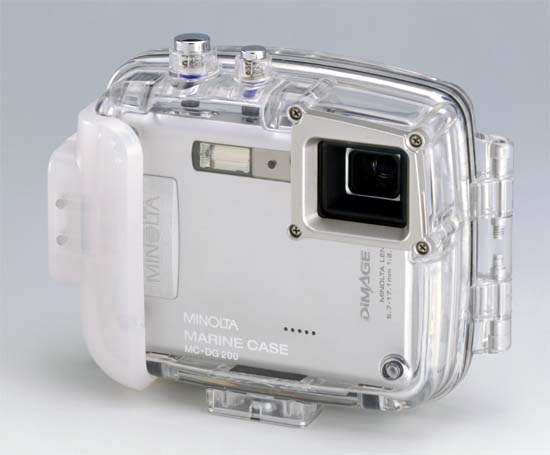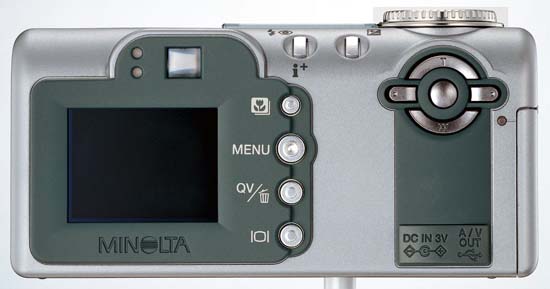 |
||
|
||
| ||
Minolta's booth had visitors all the time who wanted to try new solutions themselves. There were worthy solutions indeed. One of the interesting models is Dimage Xt camera.  As compared to its predecessor Dimage Xi, this model is more compact (5% smaller), sports a less angular shape, and has 3 g off the weight (120 g against 123 g of Xi). The battery compartment's cover has changed as well: this elegant chrome-coated component is a stylish add-on. DiMAGE Xt is so compact thanks to Minolta's exclusive optical zoom. Due to the revolutionary lens the camera's side is only 20 mm both when you shoot (none of the lens components moves outwards) and when you simply hold the camera in your pocket. The camera weighs 120 g, which is the minimal weight for this class, has a 3x optical zoom equivalent to 37 - 111 mm lens for 35mm photo cameras, and a 4x digital lens, which amount to gradual 12x magnification. The camera is ready to shoot in 1.2 sec after you switch it on. This is the record-breaking time today among all photo cameras with an optical zoom. The high-speed processor gives an instant response to your actions. The miniature motor used for the optical zoom is very quiet. All controls are located outside for comprehensive management. Minolta offers a special case for underwater shooting.  The F series was extended with two new models: more expensive F300 and more acceptable F200. The basic features of DiMAGE F300 are high quality of images of large resolutions, perfect automatic functions and quick comprehensive handling. Based on the attractive DiMAGE F100, DiMAGE F300 is one of the lightest and most compact 5.0 Mp digital photo cameras with a built-in lens.   When developing the high-accuracy optoelectronic DiMAGE F300 system, the engineers used technologies of DiMAGE 7Hi to make quality as high as possible. The heart of this system is 5.3 Mp CCD matrix 1/1.8" with 5.0 M effective pixels for highest-rsolution images. The matrix resolution allows for 32.5 X 43.3 cm prints at 150dpi or 16.3 X 21.7 cm prints of photographic quality; now you can make prints in A3 and A5 formats respectively. Minolta's GT lens utilized in DiMAGE F300 is one of the best solutions in optical systems designing. The lens composed of 8 elements in 7 groups is only 24 mm long, i.e. less than an inch when folded. The focal length makes 7.8 mm to 23.4 mm which is equivalent to 38mm - 114mm of film cameras. This focal length range suits for shooting various kinds of views starting from landscapes and interior in the wideangle mode to portraits and remote objects in the telephoto mode. The 3x zoom lens uses three aspherical elements for sharp contrast images at any focal length. Minolta's exclusive image processing technology, CxProcess, guarantees that the CCD matrix will reproduce a scene precisely. CxProcess controls sharpness, colors and contrast as well as eliminates noise for bright natural images. CxProcess controls sharpness by balancing the resolution and imaging acuity. It maintains details sharp with the DOF increased. Colors are controlled to prevent too strong color saturation; warm tones of human faces or tenderness of fresh green leaves are reproduced as precisely as a human eye perceives them. Contrast is adjusted to reach high quality of halftones and bright objects, as well as intensify shadows. One of the secrets of perfect photography is work on details. Soft color transitions and sharp imaging of even tiniest details turn a photo into a live picture. 12bit analog-digital conversion retains excellent images with tender halftones in their natural view. Billions of colors and 4,096 levels per each color channel make images look natural thanks to perfect color rendering and sharp details. This advantage is well seen in the portrait mode: soft color rendering of halftones of face skin, distinct hair and bright eyes. Image noise is a problem of any electronic system. They make images look grainy. DiMAGE F300 suppresses noise thanks to a high signal-to-noise ratio to minimize this effect even if a CCD matrix is very sensitive; also, a photographer can handle noise reduction to control image quality. A new function which can be enabled in the menu corrects dark noise resulted from long exposure (over one sec.). The auto focusing system of DiMAGE F300 makes the focusing procedure much easier. Subject Tracking Autofocus (AF) and Minolta's Area AF work together to locate and follow the subject in 3D space within the extrawide focus area, and you don't have to lock focus on a subject. If a subject starts moving the Subject Tracking Autofocus adjusts the focus to ensure sharper images; the active auto focusing sensor is displayed in the focusing frame and follows the subject. The camera's body can be either noble silver or indigo. Minolta F200 is very similar to F300, but it has 4.0 Mp which is more than enough for most tasks even for an experienced photographer.   For beginners there is 2Mp camera E223 with 3x optical zoom. S404 is upgraded up to S414. It has the same appearance but it features 4.1 Mpixels, 4x optical zoom, CxProcess and some other technologies. Here you could try Minolta's new cameras and estimate their operation. Some made shots of a luxurious bike, others stuck to professional models. But.. it's better to combine both processes.
Alexander Vorobiev (vorobiev@ixbt.com)
Write a comment below. No registration needed!
|
Platform · Video · Multimedia · Mobile · Other || About us & Privacy policy · Twitter · Facebook Copyright © Byrds Research & Publishing, Ltd., 1997–2011. All rights reserved. |